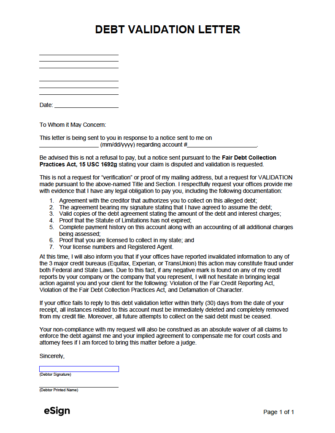

A debt verification letter is a form used to confirm whether or not a debt is genuine. It is sent to a creditor or collection agency after receiving a letter requesting payment for an unpaid balance. Per federal law (15 USC 1692g), the debt collector is required to provide information on the balance as long as the debtor sends a verification letter within thirty (30) days of the initial communication.
The verification letter should be sent via certified mail; this is an important step that provides the debtor with proof that the letter was sent within the allotted thirty (30) day window. Once received, the collector must send evidence to the debtor that the debt is valid. If no response is received from the creditor within thirty (30) days, the debt will be considered invalid.
Follow the steps below to verify if a debt is genuine.
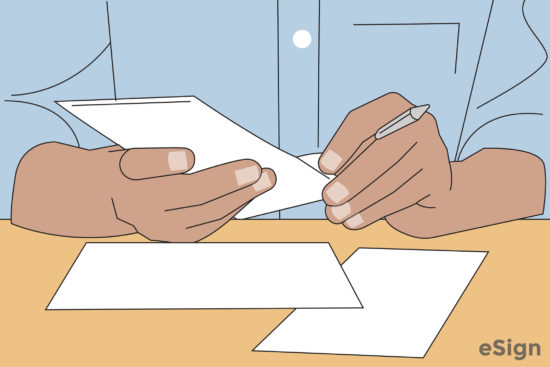
Starting from the date the debtor first receives a request for payment from the collector (the “initial contact”), they have thirty (30) days to send the validation letter. The initial contact from the collector can be from a phone call or mailed notice. While the debtor can technically send a letter after thirty (30) days, the collector won’t have a legal obligation to respond.

The purpose of the validation letter is to inform the collector that the debtor is 1) aware of their rights under the Fair Debt Collection Practices Act (FDCPA) and 2) is requesting additional information to prove the debt is accurate.
The debtor can either copy and paste the sample (below) into a new document or download the pre-written PDF or Word (.docx) version. The letter can be modified to match the tone and style of the sender.
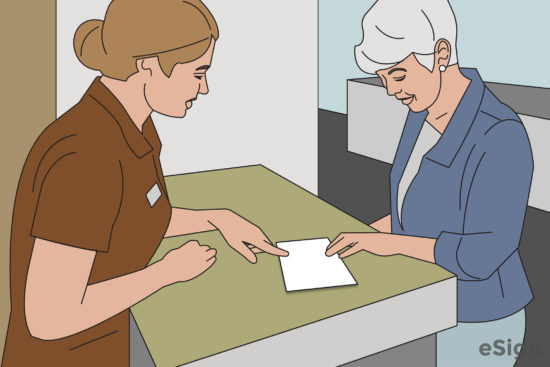
Once the letter has been completed, the debtor should sign above their printed name. While not a requirement, this adds a level of authenticity to the letter. The signature can be written by hand or digitally added with eSign.
Bring the signed letter to a nearby post office (e.g., USPS) and send the letter via “Certified Mail with signature confirmation”. Sending the letter this way creates an official paper trail, allowing the sender (debtor) to prove that the letter was successfully delivered to the collector’s address within thirty (30) days.

Once the letter has been delivered to the creditor, they will have thirty (30) days to respond. If a response isn’t received within this timeframe, the debt is considered invalid per federal law, and the debtor can move on without paying.
If the creditor tries to recollect again, the debtor can send the collector a cease-and-desist letter to stop all future collection attempts. However, because debt is often sold and resold, the debtor may need to issue additional cease-and-desist letters as time passes.
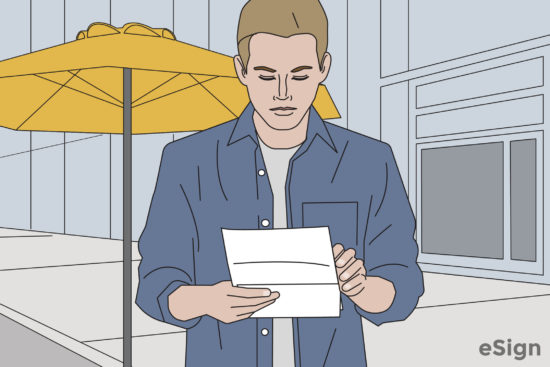
If the collector responds with information regarding the debt, the debtor must go through all provided documentation carefully while looking for anything that could point to the charge being incorrectly assigned.
If the debt is valid and it hasn’t passed the statute of limitations for the debtor’s state, the debtor can begin making payments on the debt. Alternatively, the debtor can attempt to reach a deal with the creditor by sending them a debt settlement offer letter. With the letter, the debtor offers to make an immediate, lump sum payment to the collector (for less than the total amount owed) in exchange for having the remaining debt absolved.
From:
[DEBTOR (SENDER) NAME]
[DEBTOR ADDRESS LINE 1]
[DEBTOR ADDRESS LINE 2]
To:
[CREDITOR (RECIPIENT) COMPANY]
[CREDITOR ADDRESS LINE 1]
[CREDITOR ADDRESS LINE 2]
To Whom it May Concern:
This letter is sent in response to a notice delivered to me on [MM/DD/YYYY] regarding account # [#######] .
Be advised this is not a refusal to pay but a notice sent pursuant to the Fair Debt Collection Practices Act, 15 USC 1692g stating your claim is disputed, and validation is requested.
This is not a request for “verification” or proof of my mailing address, but a request for VALIDATION made pursuant to the above-named Title and Section.
I respectfully request your offices provide me with evidence that I have any legal obligation to pay you, including the following documentation:
At this time, I will also inform you that if your offices have reported invalidated information to any of the 3 major credit bureaus (Equifax, Experian, or TransUnion), this action may constitute fraud under both Federal and State Laws. Due to this fact, if any negative mark is found on any of my credit reports by your company or the company that you represent, I will not hesitate to bring legal action against you and your client for the following: Violation of the Fair Credit Reporting Act, Violation of the Fair Debt Collection Practices Act, and Defamation of Character.
If your office fails to reply to this debt validation letter within thirty (30) days from the date of your receipt, all instances related to this account must be immediately deleted and completely removed from my credit file. Moreover, all future attempts to collect on the said debt must be ceased.
Your non-compliance with my request will be construed as an absolute waiver of all claims to enforce the debt against me and your implied agreement to compensate me for attorney fees should I be forced to bring this matter before a judge.
_________________________________
Signature
The first three (3) lines at the top of the letter are reserved for the person sending the document (i.e., the debtor). On the first line, enter the full name of the debtor, followed by their street address on the second line, and their city, state, and ZIP code on the third line.
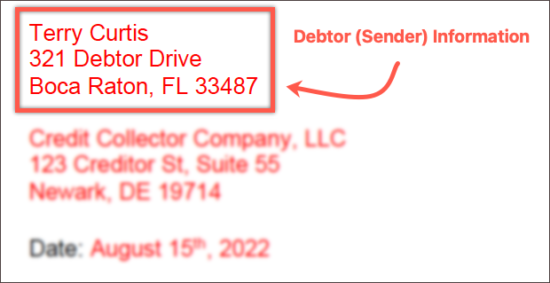
Similar to Step 1, enter the creditor’s company name on line 1, their mailing address on line 2, and their city, state, and ZIP code on line 3.
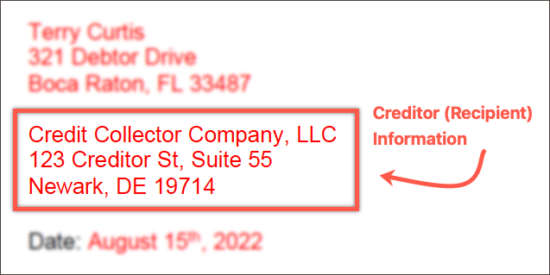
Enter the full date that the debtor will be mailing the letter.
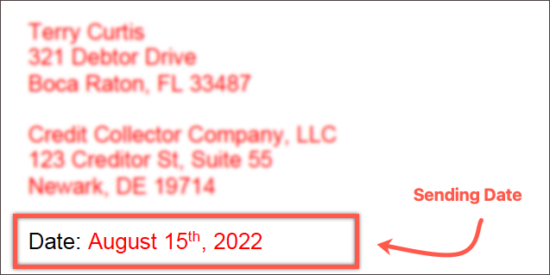
Enter the date the creditor first communicated with the debtor. Then, enter the account number (#) associated with the debt. The account number can often be found on mailed documents from the creditor. This field can be left blank or deleted if the account number is unknown.
The debtor must sign and print their name at the bottom of the letter. Their signature can be included on the document by hand or digitally added via eSign. Once complete, the letter should be mailed to the creditor via certified mail.